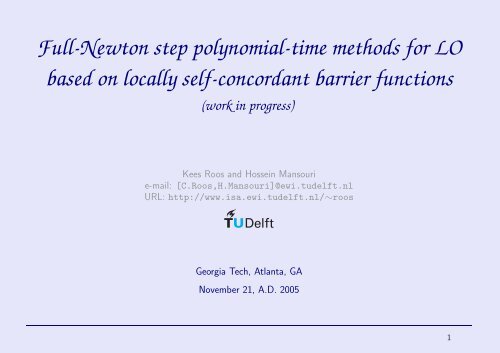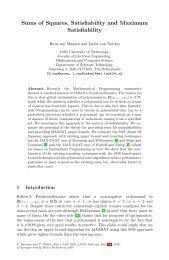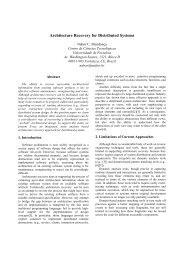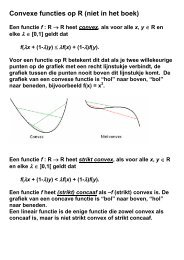Full-Newton step polynomial-time methods for LO based on locally ...
Full-Newton step polynomial-time methods for LO based on locally ...
Full-Newton step polynomial-time methods for LO based on locally ...
Create successful ePaper yourself
Turn your PDF publications into a flip-book with our unique Google optimized e-Paper software.
<str<strong>on</strong>g>Full</str<strong>on</strong>g><str<strong>on</strong>g>Newt<strong>on</strong></str<strong>on</strong>g> <str<strong>on</strong>g>step</str<strong>on</strong>g> <str<strong>on</strong>g>polynomial</str<strong>on</strong>g><str<strong>on</strong>g>time</str<strong>on</strong>g> <str<strong>on</strong>g>methods</str<strong>on</strong>g> <str<strong>on</strong>g>for</str<strong>on</strong>g> <str<strong>on</strong>g>LO</str<strong>on</strong>g><str<strong>on</strong>g>based</str<strong>on</strong>g> <strong>on</strong> <strong>locally</strong> selfc<strong>on</strong>cordant barrier functi<strong>on</strong>s(work in progress)Kees Roos and Hossein Mansourie-mail: [C.Roos,H.Mansouri]@ewi.tudelft.nlURL: http://www.isa.ewi.tudelft.nl/∼roosGeorgia Tech, Atlanta, GANovember 21, A.D. 20051
• Self-c<strong>on</strong>cordant (barrier) functi<strong>on</strong>sOutline– Definiti<strong>on</strong>s– <str<strong>on</strong>g>Newt<strong>on</strong></str<strong>on</strong>g> <str<strong>on</strong>g>step</str<strong>on</strong>g> and proximity measure– Algorithm with full <str<strong>on</strong>g>Newt<strong>on</strong></str<strong>on</strong>g> <str<strong>on</strong>g>step</str<strong>on</strong>g>s– Complexity analysis– Minimizati<strong>on</strong> of a linear functi<strong>on</strong> over a c<strong>on</strong>vex domain– Algorithm with full <str<strong>on</strong>g>Newt<strong>on</strong></str<strong>on</strong>g> <str<strong>on</strong>g>step</str<strong>on</strong>g>s– Complexity analysis• Kernel-functi<strong>on</strong>-<str<strong>on</strong>g>based</str<strong>on</strong>g> approach– Linear optimizati<strong>on</strong> via self-dual embedding– Central path of self-dual problem– Kernel-functi<strong>on</strong>-<str<strong>on</strong>g>based</str<strong>on</strong>g> barrier functi<strong>on</strong>s– Complexity results• Local self-c<strong>on</strong>cordancy of kernel-functi<strong>on</strong>-<str<strong>on</strong>g>based</str<strong>on</strong>g> barrier functi<strong>on</strong>s• Analysis of the full <str<strong>on</strong>g>Newt<strong>on</strong></str<strong>on</strong>g> <str<strong>on</strong>g>step</str<strong>on</strong>g> method• C<strong>on</strong>cluding remarks• Some references2
Self-c<strong>on</strong>cordant univariate functi<strong>on</strong>sWe start by c<strong>on</strong>sidering a univariate functi<strong>on</strong> φ : D → R. The domain D of the functi<strong>on</strong> φmust be an open interval in R. One calls φ a κ-self-c<strong>on</strong>cordant (SC) functi<strong>on</strong> if there existsa n<strong>on</strong>negative number κ such that∣∣∣φ ′′′ (x) ∣ ≤ 2κ ( φ ′′ (x) )32 , ∀x ∈ D. (1)Note that this definiti<strong>on</strong> assumes that φ ′′ (x) is n<strong>on</strong>negative, whence φ is c<strong>on</strong>vex, and moreoverthat φ is three <str<strong>on</strong>g>time</str<strong>on</strong>g>s differentiable.Moreover, if φ ′′ (x) > 0 <str<strong>on</strong>g>for</str<strong>on</strong>g> all x ∈ D, then φ is SC if and <strong>on</strong>ly ifis bounded above (by 4κ 2 ).φ ′′′ (x) 2φ ′′ (x) 33
Self-c<strong>on</strong>cordant (multivariate) functi<strong>on</strong>sLet φ : D → R be a strictly c<strong>on</strong>vex functi<strong>on</strong>, where the domain D is an open c<strong>on</strong>vex subsetof R n , with n > 1. So φ is a multivariate functi<strong>on</strong>.Then φ is called a κ-SC functi<strong>on</strong> if its restricti<strong>on</strong> to an arbitrary line in its domain is κ-SC.In other words, φ is a κ-SC if and <strong>on</strong>ly if ¯φ(t) = φ(x + th) is κ-SC <str<strong>on</strong>g>for</str<strong>on</strong>g> all x ∈ D and <str<strong>on</strong>g>for</str<strong>on</strong>g>all h ∈ R n . The domain of ¯φ(t) is defined in the natural way: given x and h it c<strong>on</strong>sists ofall t such that x + th ∈ D.We want to find the minimal value φ <strong>on</strong> its domain (if it exists) by <str<strong>on</strong>g>Newt<strong>on</strong></str<strong>on</strong>g>’s method.4
<str<strong>on</strong>g>Newt<strong>on</strong></str<strong>on</strong>g> <str<strong>on</strong>g>step</str<strong>on</strong>g> and proximity measureLet φ : D → R be a a strictly c<strong>on</strong>vex κ-SC functi<strong>on</strong> having a minimizer, and such that theminimal value equals 0. The <str<strong>on</strong>g>Newt<strong>on</strong></str<strong>on</strong>g> <str<strong>on</strong>g>step</str<strong>on</strong>g> at x is defined by∆x = −H(x) −1 g(x), (2)where g(x) and H(x) denote the gradient and the Hessian of φ(x) at x, respectively. Inthe sequel we always assume that φ is strictly c<strong>on</strong>vex. As a c<strong>on</strong>sequence, the quantity√√λ(x) = ∆x T H(x)∆x = ‖∆x‖ H(x) = g(x) T H(x) −1 g(x),can be used as a measure <str<strong>on</strong>g>for</str<strong>on</strong>g> the ‘distance’ of x to the minimizer of φ(x).The quantity λ(x) plays a crucial role in the analysis of <str<strong>on</strong>g>Newt<strong>on</strong></str<strong>on</strong>g>’s method. Many results canbe nicely expressed by using the univariate (n<strong>on</strong>negative) functi<strong>on</strong> ω(t) defined byFor example, if λ(x) < 1 κthen <strong>on</strong>e hasω(t) = t − ln(1 + t), t > −1. (3)κλ(x) + ln(1 − κλ(x))φ(x) ≤ −Hence, since ω(t) is m<strong>on</strong>ot<strong>on</strong>ically decreasing if t ∈ (−1,0], we obtainλ(x) ≤ 1 4κκ 2= ω (−κλ(x))κ 2 .⇒ φ(x) ≤ ω(−1 4 )κ 2 = 0.0376821κ 2 ≤ 126κ 2. 5
Quadratic c<strong>on</strong>vergence resultA major result in the theory of self-c<strong>on</strong>cordant functi<strong>on</strong>s states that the <str<strong>on</strong>g>Newt<strong>on</strong></str<strong>on</strong>g> process isquadratically c<strong>on</strong>vergent if 3κλ(x) < 1. This is because of the following result.Lemma 1 If κλ(x) < 1 then x + ∆x ∈ D and(λ(x)) 2.λ(x + ∆x) ≤ κ1 − κλ(x)Corollary 1 If 3κλ(x) < 1 then x + ∆x ∈ D andλ(x + ∆x) ≤ ( 32λ(x) √ κ ) 2.6
Algorithm with full <str<strong>on</strong>g>Newt<strong>on</strong></str<strong>on</strong>g> <str<strong>on</strong>g>step</str<strong>on</strong>g>sAssuming that we know a point x ∈ D with λ(x) ≤3κ 1 we can easily obtain a point x ∈ Dsuch that λ(x) ≤ ǫ, <str<strong>on</strong>g>for</str<strong>on</strong>g> prescribed ǫ > 0, with the following algorithm.Input:An accuracy parameter ǫ ∈ (0,1);x ∈ D such that λ(x) ≤ 1 3κ .while λ(x) ≤ ǫ dox := x + ∆xendwhileTheorem 1 Let x ∈ D and λ(x) ≤3κ 1 . Then the algorithm with full <str<strong>on</strong>g>Newt<strong>on</strong></str<strong>on</strong>g> <str<strong>on</strong>g>step</str<strong>on</strong>g>s requiresat most⎡⎢ log 2⎛⎝ log ǫlog 3 4⎞⎤⌈⎠≤ ⎥(log 2 3.5log 1 ǫiterati<strong>on</strong>s. The output is a point x ∈ D such that λ(x) ≤ ǫ.)⌉7
Minimizati<strong>on</strong> of a linear functi<strong>on</strong> over a c<strong>on</strong>vex domainWe c<strong>on</strong>sider the problem of minimizing a linear functi<strong>on</strong> over a closed c<strong>on</strong>vex domain ¯D:(P) min { c T x : x ∈ ¯D } .We assume that we have a self-c<strong>on</strong>cordant barrier functi<strong>on</strong> φ : D → R, where D = int ¯D,and also that H(x) = ∇ 2 φ(x) is positive definite <str<strong>on</strong>g>for</str<strong>on</strong>g> every x ∈ D. For µ > 0 we defineφ µ (x) := cT xµ+ φ(x), x ∈ D.(P µ ) inf {φ µ (x) : x ∈ D} .We haveg µ (x) := ∇φ µ (x) = c µ + ∇φ(x) = c µ + g(x)H µ (x) := ∇ 2 φ µ (x) = ∇ 2 φ(x) = H(x), ∇ 3 φ µ (x) = ∇ 3 φ(x).Note that the two higher derivatives do not depend <strong>on</strong> µ. It follows that φ µ (x) is selfc<strong>on</strong>cordant.The minimizer of φ µ (x), if it exists, is denoted as x(µ). When µ runs thoughall positive numbers then x(µ) runs through the central path of (P). We expect that x(µ)c<strong>on</strong>verges to an optimal soluti<strong>on</strong> of (P) when µ approaches 0. There<str<strong>on</strong>g>for</str<strong>on</strong>g>e we are goingto follow the central path. This approach is likely to be feasible because since φ µ (x) isself-c<strong>on</strong>cordant, its minimizer can be computed efficiently.8
<str<strong>on</strong>g>Newt<strong>on</strong></str<strong>on</strong>g> <str<strong>on</strong>g>step</str<strong>on</strong>g> and proximity measureφ µ (x) := cT xµ+ φ(x), x ∈ D.g µ (x) := ∇φ µ (x) = c µ + ∇φ(x) = c µ + g(x)H µ (x) := ∇ 2 φ µ (x) = ∇ 2 φ(x) = H(x), ∇ 3 φ µ (x) = ∇ 3 φ(x).The <str<strong>on</strong>g>Newt<strong>on</strong></str<strong>on</strong>g> <str<strong>on</strong>g>step</str<strong>on</strong>g> at x is now given by∆x = −H(x) −1 g µ (x)and the distance of x ∈ D to the µ-center x(µ) is measured by the quantity√λ µ (x) = ∆x T √H(x)∆x = g µ (x) T H(x) −1 g µ (x) = ‖g µ (x)‖ H −1 .9
Effect of a µ-update and the barrier parameter νLet λ = λ µ (x) and µ + = (1 − θ)µ. Our aim is to estimate λ µ +(x). We haveg µ +(x) = cµ + ∇φ(x) = c+ (1 − θ)µ + ∇φ(x)( )cµ + ∇φ(x) − θ∇φ(x)= 11−θHence, denoting H(x) shortly as H,λ µ +(x) = 11−θ ‖g µ(x) − θ∇φ(x)‖ H −1 ≤ 11−θ⎛⎜= 11−θ (g µ(x) − θ∇φ(x)) .⎝ ‖g µ(x)‖ H −1} {{ }λ µ (x)+θ ‖g(x)‖ H −1Definiti<strong>on</strong> 1 Let ν ≥ 0. The self-c<strong>on</strong>cordant barrier functi<strong>on</strong> φ is called a ν-barrier ifλ(x) 2 = ‖g(x)‖ 2 H −1 ≤ ν, ∀x ∈ D.⎞⎟⎠ .An immediate c<strong>on</strong>sequence of this definiti<strong>on</strong> isLemma 2 If φ is a self-c<strong>on</strong>cordant ν-barrier then λ µ +(x) ≤ λ µ(x)+θ √ ν1−θ.10
Input:Algorithm with full <str<strong>on</strong>g>Newt<strong>on</strong></str<strong>on</strong>g> <str<strong>on</strong>g>step</str<strong>on</strong>g>sAn accuracy parameter ǫ > 0;proximity parameter τ > 0;update parameter θ, 0 < θ < 1;x = x 0 ∈ D and µ = µ 0 > 0 such that λ µ (x) ≤ τ < 1 κ .(while µ ν + τ (τ+ √ ν)1−κτµ := (1 − θ)µ;x := x + ∆x;endwhile)≥ ǫ doTheorem 2 If τ =9κ 1 and θ = 5requires not more than⌈9+36κ √ ν2 ( 1 + 4κ √ ν ) ln 2µ0 νǫ, then the algorithm with full <str<strong>on</strong>g>Newt<strong>on</strong></str<strong>on</strong>g> <str<strong>on</strong>g>step</str<strong>on</strong>g>siterati<strong>on</strong>s. The output is a point x ∈ D such that c T x ≤ c T x ∗ + ǫ, where x ∗ denotes anoptimal soluti<strong>on</strong> of (P).⌉11
Graphical illustrati<strong>on</strong> of full-<str<strong>on</strong>g>Newt<strong>on</strong></str<strong>on</strong>g>-<str<strong>on</strong>g>step</str<strong>on</strong>g> path-following methodz 0µecentral pathλ(x) ≤ τz k = x k s k(1 − θ)µez 1One iterati<strong>on</strong>.12
Relevant part of the analysis of the algorithmAt the start of the first iterati<strong>on</strong> we have x ∈ D and µ = µ 0 such that λ µ (x) ≤ τ. When the barrier parameteris updated to µ + = (1 − θ)µ, Lemma 2 givesλ µ +(x) ≤ λ µ(x) + θ √ ν1 − θ≤ τ + θ√ ν1 − θ . (4)Then after the <str<strong>on</strong>g>Newt<strong>on</strong></str<strong>on</strong>g> <str<strong>on</strong>g>step</str<strong>on</strong>g>, the new iterate is x + = x + ∆x and( ) 2λ µ +(x + λµ +(x)) ≤ κ. (5)1 − κλ µ +(x)The algorithm is well defined if we choose τ and θ such that λ µ +(x + ) ≤ τ. To get the lowest iterati<strong>on</strong> bound,we need at the same <str<strong>on</strong>g>time</str<strong>on</strong>g> to maximize θ. From (5) we deduce that λ µ +(x + ) ≤ τ certainly holds ifλ µ +(x)1 − κλ µ +(x) ≤ √ τ√ κ,which is equivalent to λ µ +(x) ≤the following c<strong>on</strong>diti<strong>on</strong> <strong>on</strong> θ:√ τκ √ τ+ √ κ . According to (4) this will hold if τ+θ√ ν1−θθ ≤ √ τ1 − κτ − √ κτ√ τ +√ νκ( 1 +√ κτ)≤√ τκ √ τ+ √ . This leads toκWe choose τ = 1 9κ . The upper bound <str<strong>on</strong>g>for</str<strong>on</strong>g> θ gets the value 59+36κ √ ν ≤ 12+8κ √ ν , and then λ µ+(x) ≤ 1 4κ .This justifies the choice of the value of τ and θ in the theorem. For the rest of the proof we refer to the relevantreferences.13
Linear optimizati<strong>on</strong> via self-dual embedding (1)It is now well known that every linear optimizati<strong>on</strong> problem can be solved efficiently if we canfind in <str<strong>on</strong>g>polynomial</str<strong>on</strong>g> <str<strong>on</strong>g>time</str<strong>on</strong>g> a strictly complementary soluti<strong>on</strong> of problems of the <str<strong>on</strong>g>for</str<strong>on</strong>g>m(SP) min{q T x : Mx + q ≥ 0, x ≥ 0},where the n ×n matrix M is skew-symmetric (i.e., M T = −M) and q = (0; . . .;0; n) ∈R n , and under the assumpti<strong>on</strong> that the all-<strong>on</strong>e vector 1 is feasible with M 1 + q = 1.The problem (SP) is trivial in the sense that it has a trivial optimal soluti<strong>on</strong>, namely x = 0,with 0 as optimal value. But this observati<strong>on</strong> is not sufficient <str<strong>on</strong>g>for</str<strong>on</strong>g> our goal, since we need astrictly complementary soluti<strong>on</strong> of (SP). What this means requires some explanati<strong>on</strong>.14
Linear optimizati<strong>on</strong> via self-dual embedding (2)We associate to any vector x ∈ R n its slack vector s(x) according tos(x) = Mx + q.In the sequel we simply denote s(x) as s, and s will always have this meaning. Since M isskew-symmetric we have z T Mz = 0 <str<strong>on</strong>g>for</str<strong>on</strong>g> every vector z ∈ R n . Hence we haveq T x = (s − Mx) T x = s T x − x T Mx = s T x.There<str<strong>on</strong>g>for</str<strong>on</strong>g>e, if x is feasible, then x is optimal if and <strong>on</strong>ly if s T x = 0. Since x and s aren<strong>on</strong>negative this holds if and <strong>on</strong>ly if x i s i = 0 <str<strong>on</strong>g>for</str<strong>on</strong>g> each i. This shows that x is optimalif and <strong>on</strong>ly if the vectors x and s are complementary vectors. We say that x is a strictlycomplementary soluti<strong>on</strong> if moreover x i + s i > 0 <str<strong>on</strong>g>for</str<strong>on</strong>g> each i.Summarizing these facts, we have that x is feasible if x ≥ 0 and s ≥ 0. A feasible x isoptimal if xs = 0, and x is a strictly complementary soluti<strong>on</strong> if moreover x + s > 0. Thuswe need to solve the systems = Mx + q, x ≥ 0, s ≥ 0,xs = 0x + s > 0.15
Central pathThe basic idea of IPMs is to replace the so-called complementarity c<strong>on</strong>diti<strong>on</strong> xs = 0 <str<strong>on</strong>g>for</str<strong>on</strong>g>(SP), by the parameterized equati<strong>on</strong> xs = µ1, with µ > 0. Thus we c<strong>on</strong>sider the systems = Mx + q, x ≥ 0, s ≥ 0,xs = µ1.Clearly, any soluti<strong>on</strong> (x, s) will satisfy x > 0 and s > 0. Note that x = s = 1 and µ = 1satisfy this system.Surprisingly enough, a soluti<strong>on</strong> exists <str<strong>on</strong>g>for</str<strong>on</strong>g> each µ > 0, and this soluti<strong>on</strong> is unique. It isdenoted as (x(µ), s(µ)) and we call x(µ) the µ-center of (SP); s(µ) is the corresp<strong>on</strong>dingslack vector. The set of µ-centers (with µ running through all positive real numbers) givesa homotopy path, which is called the central path of (SP). If µ → 0 then the limit ofthe central path exists and since the limit point satisfies the complementarity c<strong>on</strong>diti<strong>on</strong>, thelimit yields an optimal soluti<strong>on</strong> <str<strong>on</strong>g>for</str<strong>on</strong>g> (SP). Moreover, this soluti<strong>on</strong> can be shown to be strictlycomplementary.We will start our method at x = s = 1 and µ = 1. The method uses n<strong>on</strong>negative barrierfuncti<strong>on</strong>s φ µ (x, s), <str<strong>on</strong>g>for</str<strong>on</strong>g> each µ > 0, such that φ µ (x(µ), s(µ)) = 0. If s = Mx + q thenwe denote φ µ (x, s) as Φ µ (x).16
Kernel-functi<strong>on</strong>-<str<strong>on</strong>g>based</str<strong>on</strong>g> barrier functi<strong>on</strong>sFirst we choose a kernel functi<strong>on</strong> ψ : (0, ∞) → [0, ∞). We require that ψ(t) is three<str<strong>on</strong>g>time</str<strong>on</strong>g>s differentiable and strictly c<strong>on</strong>vex, and moreover that ψ(t) is minimal at t = 1, whereasψ(1) = 0. Then we define√ n∑xsΦ µ (x) := φ µ (x, s) = 2 ψ (v i ) where v := , s = Mx + q.µi=1The barrier functi<strong>on</strong> Φ µ (x) <str<strong>on</strong>g>based</str<strong>on</strong>g> <strong>on</strong> the kernel functi<strong>on</strong> ψ(t) is defined <strong>on</strong> the interior ofthe domain of (SP).φ µ (x, s) is strictly c<strong>on</strong>vex and minimal when v = 1, and then x = x(µ) (and s = s(µ)).Provided that θ is small enough, after a full <str<strong>on</strong>g>Newt<strong>on</strong></str<strong>on</strong>g> <str<strong>on</strong>g>step</str<strong>on</strong>g> we get a good enough approximati<strong>on</strong>of x = x(µ). Then we repeat the above process: reduce µ by the factor 1 − θ, do a full<str<strong>on</strong>g>Newt<strong>on</strong></str<strong>on</strong>g> <str<strong>on</strong>g>step</str<strong>on</strong>g>, etc., until µ is close enough to zero. At the end this yields an ǫ-soluti<strong>on</strong> of theproblem (SP).In earlier papers we used a search directi<strong>on</strong> determined by the systemM∆x = ∆s,s∆x + x∆s = −µ v ψ ′ (v).17
Complexity resultsi kernel functi<strong>on</strong> ψ i (t) small-update large-update ref.t12 −12 − ln t O ( √ ) n lnnO ( )n ln n RTVǫǫ( )122 t −1 2O ( √ ) ( )tn lnnO n 2 3 ln n PRTǫǫt32 −12 + t1−q −1q−1 , q > 1 O ( q 2√ ) )n ln n O(qn q+12qln n PRTǫǫt42 −12 + t1−q −1q(q−1) − q−1q (t − 1), q > 1 O ( q √ n ) )ln n O(qn q+12qln n PRTǫ ǫ56t 2 −12 + e1 t −eet 2 −12 − ∫ t −1 1 e1 ξdξ O ( √ n lnnǫO ( √ ) n lnnO ( √ǫ n ln 2 n ) ln n BERǫ)O ( √ n ln 2 n ) ln n BERǫ7 t − 1 + t1−q −1q−1 , q > 1 O ( q 2√ n ) ln n ǫO(qn) ln n ǫBRIn all cases the iterati<strong>on</strong> bound <str<strong>on</strong>g>for</str<strong>on</strong>g> small-update <str<strong>on</strong>g>methods</str<strong>on</strong>g> is O ( √ n lognǫ).The best bound <str<strong>on</strong>g>for</str<strong>on</strong>g> large-update <str<strong>on</strong>g>methods</str<strong>on</strong>g> is obtained <str<strong>on</strong>g>for</str<strong>on</strong>g> i ∈ {3,4} by taking q = 1 2log n.This gives the iterati<strong>on</strong> bound O ( √ )n(log n)lognǫ, which is currently the best knownbound <str<strong>on</strong>g>for</str<strong>on</strong>g> large-update <str<strong>on</strong>g>methods</str<strong>on</strong>g>.18
Local self-c<strong>on</strong>cordancy of the barrier functi<strong>on</strong>We define φ : D → R to be <strong>locally</strong> κ-SC at x ∈ D ⊆ R n if φ(x + th) is κ-SC <str<strong>on</strong>g>for</str<strong>on</strong>g> allh ∈ R n ; to express the dependence of κ <strong>on</strong> x we use the notati<strong>on</strong> κ(x). Clearly φ is κ-SCif and <strong>on</strong>ly if κ(x) is bounded above by some (finite) c<strong>on</strong>stant <strong>on</strong> the domain of φ.It is well known that the classical logarithmic barrier functi<strong>on</strong>—whose kernel functi<strong>on</strong> is t2 −12 −ln t—is SC. But this is quite excepti<strong>on</strong>al. In general kernel-functi<strong>on</strong>-<str<strong>on</strong>g>based</str<strong>on</strong>g> barrier functi<strong>on</strong>sare not SC, but they are <strong>locally</strong> SC. The following table shows this <str<strong>on</strong>g>for</str<strong>on</strong>g> the kernel functi<strong>on</strong>,ψ 2 (t).iterati<strong>on</strong> boundslocal value of κi kernel functi<strong>on</strong> ψ i (t) small-update large-update ψ(t) Φ µ (x)1t 2 −12 − ln t O ( √ ) ( )n lnnǫO n lnnǫ1 1( )2 t −1 2tO ( √ )n lnnǫ?122t √32‖v‖ ∞√3At the start of the algorithm we have v = 1, where the local value of κ is 2/ √ 3. Duringthe course of the algorithm the iterates stay so close to the central path that v stays in a verysmall neighborhood of 1, and hence the barrier functi<strong>on</strong> is SC <str<strong>on</strong>g>for</str<strong>on</strong>g> some suitable value of κ,slightly larger than 2/ √ 3.19
Assumpti<strong>on</strong>s <strong>on</strong> the kernel functi<strong>on</strong>We assume thatand we make the following assumpti<strong>on</strong>s:ψ(t) = 1 2(t 2 − 1 ) + ψ b (t) (6)ψ b ′ (t) < 0, ψ′′b (t) > 0, ψ′′′b (t) < 0, t > 0.It will be c<strong>on</strong>venient to use the following notati<strong>on</strong>s (<str<strong>on</strong>g>for</str<strong>on</strong>g> t > 0):ξ(t) := ψ ′′ (t) − ψ′ (t)t, ξ b (t) = ψ ′′b (t) − ψ′ b (t)t. (7)Note that these definiti<strong>on</strong>s implyξ(t) = ξ b (t) > 0, t > 0.20
C<strong>on</strong>sequences of the assumpti<strong>on</strong>For x > 0 and s > 0 we haveφ µ (x, s) = 2n∑i=1Hence, if s := s(x) = Mx + q thenΦ µ (x) = φ µ (x, s) = xT s − nµµψ (v i ) =+2n∑j=1n∑i=1(v2i − 1 ) + 2n∑i=1ψ b(vj)=q T x − nµµψ b (v i ) .+2n∑j=1ψ b(√xj s jµ).In the special case that ψ(t) is the kernel functi<strong>on</strong> of the logarithmic barrier functi<strong>on</strong> we haveψ b (t) = −ln t, whenceφ µ (x, s) = qT xµ − n ∑j=1ln ( x j s j)+ nln µ − n,which is (up to the ’c<strong>on</strong>stant’ term nln µ − n) the classical primal-dual logarithmic barrierfuncti<strong>on</strong>.21
Results <strong>on</strong> local self-c<strong>on</strong>cordancy (1)LetN(t) = √−ψ′ b (t) t > 0.(t),ψ ′′bTheorem 3 ν(x, s) = 2 ‖N(v)‖ 2 .It is quite surprising that the local value of ν depends <strong>on</strong>ly <strong>on</strong> the vector v. Recall that ifx ≈ x(µ) and s ≈ s(µ) then v ≈ 1.We give two examples.i ψ i (t) ψ b (t) ψ ′ b1 t2 −12 1 2(t) ψ′′b2 − ln t −ln t −1 t( )t −1 2 ( 12tt −2 − 1 ) −1 3t 3 t 4(t) ψ′′′b(t) ν(t) ν(v)1t 2 − 2 t 3 2 2n−12t 52t −232‖v −1 ‖ 2322
Proof of Theorem 3We apply the compositi<strong>on</strong> rule, which is well known.Lemma 3 Let φ i be (κ i , ν i )-SCB’s <strong>on</strong> D i , <str<strong>on</strong>g>for</str<strong>on</strong>g> i = 1,2. Then φ 1 + φ 2 is a (κ, ν)-SCB<str<strong>on</strong>g>for</str<strong>on</strong>g> D 1 × D 2 , where κ = max {κ 1 , κ 2 } and ν = ν 1 + ν 2 .Since the linear part in φ µ (x, s) is 0-self-c<strong>on</strong>cordant, with ν = 0, it suffices to c<strong>on</strong>siderf(x, s) = 2n∑j=1ψ b(√xj s jµwhere s = s(x) = Mx + q. In the sequel we will neglect this relati<strong>on</strong> between s and x.Thus we will prove that f(x, s) is (κ, ν)-self-c<strong>on</strong>cordant <strong>on</strong> the set{(x, s) : x ∈ Rn+ , s ∈ R n }+ .),This will imply that f(x, s) is a (κ, ν)-self-c<strong>on</strong>cordant barrier functi<strong>on</strong> <str<strong>on</strong>g>for</str<strong>on</strong>g> the domain of(SP), which is the intersecti<strong>on</strong> of this set and affine space determined by s = Mx + q.We do this by c<strong>on</strong>sidering each of the terms in the definiti<strong>on</strong> separately and then apply thecompositi<strong>on</strong> rules of Lemma 3.23
The case n = 1 (1)(√ )xsf(x, s) = 2ψ b , x > 0, s > 0.µNow let σ, τ ∈ R and α such that x + ασ > 0 and s + ατ > 0. We defineandWritingv =√ √xs (x + ασ)(s + ατ)µ , v(α) = ,µϕ(α) = f(x + ασ, s + ατ) = 2h = σ x ,k = τ sn∑j=1ψ b (v(α)) .we have, using xs = µv 2 ,(x + ασ)(s + ατ) = xs(1 + αh)(1 + αk) = µv 2 (1 + αh)(1 + αk) ,and hencev(α) 2 = v 2 (1 + αh)(1 + αk) .24
The case n = 1 (2)v(α) 2 = v 2 (1 + αh)(1 + αk) .Taking successive derivatives with respect to α at both sides we obtain2v(α)v ′ (α) = v 2 (h(1 + αk) + k(1 + αh))v(α)v ′′ (α) + v ′ (α) 2 = v 2 hkv(α)v ′′′ (α) + 3 v ′ (α)v ′′ (α) = 0.Substituti<strong>on</strong> of α = 0 givesThis givesv(0) 2 = v 22v ′ (0) = v (h + k)vv ′′ (0) + v ′ (0) 2 = v 2 hkvv ′′′ (0) + 3v ′ (0)v ′′ (0) = 0.v(0) = vv ′ (0) = 1 2v (h + k)v ′′ (0) = − 1 4v (h − k)2v ′′′ (0) = 3 8 v (h + k)(h − k)2 .25
SinceThe case n = 1 (3)ϕ ′ (α) = 2ψb ′ (v(α)) v′ (α)ϕ ′′ (α) = 2 [ ψb ′′(v(α))v′ (α) 2 + ψb ′ (v(α)) v′′ (α) ]ϕ ′′′ (α) = 2 [ ψ ′′′b (v(α)) v′ (α) 3 + 3ψ ′′b (v(α)) v′ (α)v ′′ (α) + ψ ′ b (v(α)) v′′′ (α) ] ,it follows thatϕ ′ (0) = 2ψb ′ (v) v′ (0)ϕ ′′ (0) = 2 [ ψb ′′(v)v′ (0) 2 + ψb ′ (v) v′′ (0) ]ϕ ′′′ (0) = 2 [ ψb ′′′(v)v′ (0) 3 + 3ψb ′′(v)v′ (0)v ′′ (0) + ψb ′ (v) v′′′ (0) ] .Substituti<strong>on</strong> of of the above expressi<strong>on</strong>s <str<strong>on</strong>g>for</str<strong>on</strong>g> v(0), v ′ (0), v ′′ (0) and v ′′′ (0) yields(8)ϕ ′ (0) = ψb ′ (v) v (h + k)[ψ′′ϕ ′′ (0) = 1 2 b (v) v2 (h + k) 2 − ψb ′ (v) v (h − k)2]ϕ ′′′ (0) = 1 [4 ψ′′′b (v) v2 (h + k) 2 − 3 ξ b (v) v (h − k) 2] v (h + k) .Lemma 4 φ µ (x, s) is strictly c<strong>on</strong>vex.26
Computati<strong>on</strong> of νTo compute the barrier parameter ν we need to find an upper bound <str<strong>on</strong>g>for</str<strong>on</strong>g>Substitutingwe haveν = maxy,z(ϕ ′ (0) ) [2ψ′ϕ ′′ (0) = b(v) v (h + k)[1 ψ′′b (v) v2 (h + k) 2 − ψb ′ (v) v (h − . (9)k)2]12[ψ′′2y = h + k, z = h − k,[ψ′b(v) vy ] 2] 2b (v) v2 y 2 − ψ ′ b (v) vz2] = 2 [ ψ ′ b (v) ] 2ψ ′′b (v) = 2N(v) 2 .Thus we have proved the following lemma.Lemma 5 If n = 1, and N(t) is as defined be<str<strong>on</strong>g>for</str<strong>on</strong>g>e, then ν(x, s) = 2N(v) 2 .Theorem 3 If n ≥ 1 then ν = 2 ‖N(v)‖ 2 .Proof: This is an immediate c<strong>on</strong>sequence of Lemma 3 and Lemma 5.•27
We definewhereResults <strong>on</strong> local self-c<strong>on</strong>cordancy (2)K(t) =¯ρ(t) √ 21 −ψb ′′′(t)(,3 − ¯ρ(t) ψ′′b (t))3 2√ρ(t) = ψ′ b(t) ψ′′′b (t)ξ b (t)ψb ′′(t), ¯ρ(t) = min[2, ρ(t)] , ξ b(t) = ψ b ′′ (t) − ψ′ b (t) .tTheorem 4 κ(x, s) = ‖K(v)‖ ∞ .i ψ i (t) ψ b (t) ψ ′ b1 t2 −12 1 2(t) ψ′′b2 − ln t −ln t −1 t( )t −1 2 ( 12tt −2 − 1 ) −1 3t 3 t 4(t) ψ′′′b(t) ξ(t) ρ(t) κ(t) κ(v)1t 2 − 2 2t 3 t 2 1 1 1−12t 5 4t 4 12t √32‖v‖ ∞√328
Proof of Theorem 4 (1)We first c<strong>on</strong>sider the case where n = 1. Then that κ = κ(x, s) is defined by2κ = maxh,kSubstitutingget⎧⎪⎨⎪⎩∣ ϕ ′′′ (0) ∣ ∣(ϕ ′′ (0)) 3 2=∣ 1 4[ψ′′′2 √ 2 κ = maxy,zb (v) v2 (h + k) 2 − 3 ξ(v) v (h − k) 2] v (h + k)[ [ 12 ψ′′b (v) v2 (h + k) 2 − ψb ′ (v) v (h − k)2]]3 2y = h + k, z = h − k,[ ∣ ψ′′′b (v) v2 y 2 − 3 ξ(v) vz 2] vy[ψ′′b (v) v2 y 2 − ψb ′ (v) vz2]3 2The last expressi<strong>on</strong> is homogeneous in (y, z). It follows that2 √ 2 κ = max {∣ [∣ ψ′′′b (v) v2 y 2 − 3 ξ(v) vz 2] vy∣ : ψ b ′′ (v) v2 y 2 − ψ b ′ (v) vz2 = 1 } .Be<str<strong>on</strong>g>for</str<strong>on</strong>g>e proceeding we recall the definiti<strong>on</strong>s of ρ(t) and ¯ρ(t):Note that ¯ρ(t) ∈ (0,2].∣ρ(t) = ψ′ b(t) ψ′′′b (t)ξ(t)ψ ′′ , ¯ρ(t) = min[2, ρ(t)] . (10)(t)b∣.29⎫∣⎪⎬⎪⎭.
Proof of Theorem 4 (2)2 √ 2 κ = max {∣ ∣ [ ψ ′′′b (v) v 2 y 2 − 3 ξ(v) vz 2] vy ∣ ∣ : ψ′′b (v) v 2 y 2 − ψ ′ b(v) vz 2 = 1 } . (11)The optimality c<strong>on</strong>diti<strong>on</strong>s are, <str<strong>on</strong>g>for</str<strong>on</strong>g> some suitable multiplier λ,or, equivalently,3ψ ′′′b (v) v3 y 2 − 3 ξ(v) v 2 z 2 = 3λ ψ ′′b (v) v2 y−6 ξ(v) v 2 yz = 3λ [ −ψ ′ b (v) vz] ,ψ ′′′b (v) vy2 − ξ(v) z 2 = λ ψ ′′b (v) y2 ξ(v) vyz = λ ψ ′ b (v) z. (12)We see that either z = 0 or 2 ξ(v) vy = λ ψ ′ b (v).If z = 0 then the c<strong>on</strong>straint in our problem implies that ψb ′′(v)v2 y 2 = 1, and hence (since(v) < 0), κ is in this case given byψ ′′′b2 √ 2 κ = − ψ′′′ b (v)(. (13)ψ′′b (v))3 230
Proof of Theorem 4 (3)Now assuming z ≠ 0, we can eliminate λ by substituting 2 ξ(v) vy = λ ψb ′ (v) into (12),which givesψ b ′ [ (v) ψ′′′b (v) vy2 − ξ(v) z 2] = λ ψ b ′ (v) ψ′′ b (v) y = 2 ξ(v)ψ′′ b (v) vy2 .Rearranging the terms, and using (10) we obtain−ψ ′ b (v)ξ(v) z2 = [ 2 ξ(v)ψ ′′b (v) − ψ′ b (v)ψ′′′ b (v) ]vy 2 = (2−ρ(v)) ξ(v)ψ ′′b (v) vy2 ,yielding−ψ ′ b (v) z2 = (2 − ρ(v)) ψ ′′b (v) vy2 , (14)Since −ψb ′ (v) > 0 and ψ′′b(v) > 0, this equati<strong>on</strong> has no n<strong>on</strong>zero soluti<strong>on</strong> <str<strong>on</strong>g>for</str<strong>on</strong>g> y if ρ(v) > 2,and hence κ is then given by (13).If ρ(v) ≤ 2, substituti<strong>on</strong> of (14) into the c<strong>on</strong>straint ψ ′′b (v) v2 y 2 − ψ ′ b (v) vz2 = 1 yieldsor, equivalently,Henceψ ′′b (v) v2 y 2 + (2 − ρ(v)) ψ ′′b (v) v2 y 2 = 1,[3 − ρ(v)] ψ ′′b (v) v2 y 2 = 1. (15)vy =±1√[3 − ρ(v)] ψb ′′(16)(v).31
Proof of Theorem 4 (4)The rest of the proof c<strong>on</strong>sists of computing the value of the objective functi<strong>on</strong> using therelati<strong>on</strong>s found so far. Using (14), (10) and (15), respectively, we may write2 √ [2 κ = ± ψb ′′′ (2−ρ(v)) ψ′′(v) − 3 ξ(v)b (v) ]−ψb ′(v) v 3 y 3= ± 1 [ψb ′ ψ′ (v) b(v) ψb ′′′](v) + 3 (2 − ρ(v)) ξ(v)ψ′′b (v) v 3 y 3= ± ξ(v)ψ′′ b (v)ψb ′(v) [ρ(v) + 3(2 − ρ(v))] v 3 y 3= ±2 ξ(v) [ψb ′ (3 − ρ(v)) ψ′′(v) b (v) v2 y 2] vy = ±2 ξ(v)Finally, using (10) and (16) respectively, we get (since we are maximizing)2 √ 2 κ = ±2ξ(v)±2ξ(v)ψb ′ vy =(v)ψ ′ b(v)vy.ψb ′ √[3 (v) − ρ(v)] ψb ′′(v)= 2√ρ(v) (3 − ρ(v))−ψ ′′′b (v)(ψ′′b (v) )32.For ρ(v) = 2 this yields exactly the same value as in (13). Thus the following holds.Lemma 6 If n = 1, and with K(t) as defined above, we have κ(x, s) = K(v).Theorem 4 If n ≥ 1 then κ = ‖K(v)‖ ∞ .Proof: This is an immediate c<strong>on</strong>sequence of Lemma 3 and Lemma 6.•32
Summary of resultsFrom now <strong>on</strong> we assume that s = Mx + q. Our ingredients areTheorem 3 ν(x) = 2 ‖N(v)‖ 2 , where N(t) = √−ψ′ b (t) .ψb ′′(t)Theorem 4 κ(x) = ‖K(v)‖ ∞ , where K(t) =.1¯ρ(t) √ √ 2 3−¯ρ(t)−ψ ′′′b (t)(ψ′′b (t))3 2, withρ(t) = ψ′ b(t) ψ′′′b (t)ξ b (t)ψb ′′(t), ¯ρ(t) = min[2, ρ(t)] , ξ b(t) = ψ b ′′ (t) − ψ′ b (t) .tLemma 7 During the course of the algorithm we have λ(x) ≤ 1 4κ .This lemma impliesφ µ (x, s) = 2n∑i=1ψ (v i ) ≤ ω(−1 4 )κ 2 = 0.0376821κ 2 ≤ 126κ 2 33
Some examples of barier functi<strong>on</strong>s and their local κ and ν valuesi ψ b (t) ψb ′ (t) ψ′′b (t)ψ′′′ b (t) ξ b(t) ρ(t) ν(t) κ(t)1 −log t − 1 t1− 2 21 1 1t 2 t 3 t 22 1 2( t −2 − 1 ) − 1 t 3 3t 4 − 12t 5 4t 4 123t 22t √334t 1−q −1q−1−t −q qt −q−1 −q(q + 1)t −q−2 (q + 1)t −q−1 1e 1 t −ee− e1 t −1 1+2te 1 −1 t 2 t 4 t − 1+6t+6t2 e 1 −1 1+3tt 6 t e 1 −1 1+6t+6t2t 4 t1+5t+6t 25 − ∫ t −1 1 e1 ξdξ −e 1 −1 t e1 t −1− 1+2t e 1 −1 1+tt 2 t 4 t e 1 −1 1+2tt 2 t6e σ(1−t) −1−e σ(1−t) σe σ(1−t) −σ 2 eσ(1−t) 1+σteσ(1−t) σtσ t 1+σt2qt q−12 e 1 t −11+2t(1+3t)2t 2 e 1 −1 1+ttt √1+t2e σ(1−t)σ(q+1)t q−122 √ q√1+5t+6t 22+9t+12t 2√(2+4t) e 1 t −1(1+σt)√1+t2+t2e 1 t −1√t √ 2σe σ(1−t)1+σt3+2σt34
Analysis of the algorithm (1)Note that ψ(t) is m<strong>on</strong>ot<strong>on</strong>ically decreasing <str<strong>on</strong>g>for</str<strong>on</strong>g> t ≤ 1 and m<strong>on</strong>ot<strong>on</strong>ically increasing <str<strong>on</strong>g>for</str<strong>on</strong>g> t ≥ 1.In the sequel we denote by ̺ : [0, ∞) → [1, ∞) the inverse functi<strong>on</strong> of ψ(t) <str<strong>on</strong>g>for</str<strong>on</strong>g> t ≥ 1 andby χ : [0, ∞) → (0,1] the inverse functi<strong>on</strong> of ψ(t) <str<strong>on</strong>g>for</str<strong>on</strong>g> 0 < t ≤ 1. So we haveand̺(s) = t ⇔ s = ψ(t), s ≥ 0, t ≥ 1. (17)χ(s) = t ⇔ s = ψ(t), s ≥ 0, 0 < t ≤ 1. (18)Note that χ(s) is m<strong>on</strong>ot<strong>on</strong>ically decreasing and ̺(s) is m<strong>on</strong>ot<strong>on</strong>ically increasing in s ≥ 0.Lemma 8 Let t > 0 and ψ(t) ≤ s. Then χ(s) ≤ t ≤ ̺(s) .Proof: This is almost obvious. Since ψ(t) is strictly c<strong>on</strong>vex and minimal at t = 1, withψ(1) = 0, ψ(t) ≤ s implies that t bel<strong>on</strong>gs to a closed interval whose extremal points areχ(s) and ̺(s).•35
Graphical illustrati<strong>on</strong> of the functi<strong>on</strong>s χ(s) and ̺(s)ψ(t)111098s765432100 1 2 3 4 5χ(s)̺(s)t36
The local values of κ and ν are given byκ(x) = maxiWe need to find values of κ and ν such thatAnalysis of the algorithm (2)K(v i ), ν(x) = 2n∑i=1N (v i ) 2 .κ(x) ≤ κ,ν(x) ≤ ν<str<strong>on</strong>g>for</str<strong>on</strong>g> each v that occurs during the course of the algorithm. This certainly holds ifφ µ (x, s) = 2n∑i=1The left-hand side of this implicati<strong>on</strong> impliesψ (v i ) ≤ 126κ 2 ⇒ max K(v i ) ≤ κ, 2iψ (v i ) ≤ 152κ2, i = 1, . . . , n.According to Lemma 8 this implies( ) ( )1 1χ52κ 2 ≤ v i ≤ ̺52κ 2 , i = 1, . . . , n.n∑i=1N (v i ) 2 ≤ ν.37
χAnalysis of the algorithm (3)( 152κ 2 )≤ v i ≤ ̺( 152κ 2 ), i = 1, . . . , n.If we choose κ such that( ( )) 1K ̺52κ 2 ≤ κ (19)then the barrier functi<strong>on</strong> is <strong>locally</strong> κ-SC. The above inequality certainly has a soluti<strong>on</strong>, becauseif κ goes to infinity then the left-hand side approaches K(1), which is finite, whereas theright-hand side goes to ∞. Let ¯κ denote the smallest soluti<strong>on</strong> of (19).Finally, if we take ¯ν such that( ( ( ))) 1 2¯ν = 2n N χ52¯κ 2then the barrier functi<strong>on</strong> is a <strong>locally</strong> (¯κ,¯ν)-SC barrier functi<strong>on</strong>.38
Analysis of the algorithm (4)Substituti<strong>on</strong> of the chosen values of κ and ν yields (also using that µ 0 = 1) the followingiterati<strong>on</strong> bound <str<strong>on</strong>g>for</str<strong>on</strong>g> the algorithm:⌈2 ( 1 + 4¯κ √¯ν ) ln 2¯νǫ⌉=⎡⎢2(1 + 4¯κN( ( 1)) √)χ 2n52¯κ 2ln 2n( N ( χ ( 1ǫ))) 2⎤52¯κ 2 ⎥Note that apart from n the coefficients occurring in this expressi<strong>on</strong> depend <strong>on</strong>ly <strong>on</strong> the kernelfuncti<strong>on</strong> ψ, and not <strong>on</strong> n. Thus we may safely state that <str<strong>on</strong>g>for</str<strong>on</strong>g> every kernel functi<strong>on</strong> satisfyingour c<strong>on</strong>diti<strong>on</strong>s the iterati<strong>on</strong> bound is( √nlog)nO .ǫ.39
C<strong>on</strong>cluding remarks• Recently we have used kernel functi<strong>on</strong>-<str<strong>on</strong>g>based</str<strong>on</strong>g> barrier functi<strong>on</strong>s (including so-called selfregularkernel functi<strong>on</strong>s) to improve the iterati<strong>on</strong> bound <str<strong>on</strong>g>for</str<strong>on</strong>g> large-update <str<strong>on</strong>g>methods</str<strong>on</strong>g> fromO(nlog n ǫ ) to O(√ n(log n)log n ǫ). We were surprised to observe (most of the <str<strong>on</strong>g>time</str<strong>on</strong>g>after a tedious analysis, <str<strong>on</strong>g>for</str<strong>on</strong>g> each kernel functi<strong>on</strong> separately) that the iterati<strong>on</strong> bounds<str<strong>on</strong>g>for</str<strong>on</strong>g> small-update <str<strong>on</strong>g>methods</str<strong>on</strong>g> <str<strong>on</strong>g>based</str<strong>on</strong>g> <strong>on</strong> these barrier functi<strong>on</strong>s always turned out to beO( √ nlog n ǫ ).• The current results seem to explain this phenomen<strong>on</strong>.• The results presented in this talk can be easily generalized to other (symmetric) c<strong>on</strong>eoptimizati<strong>on</strong> problems, like sec<strong>on</strong>d-order c<strong>on</strong>e optimizati<strong>on</strong> and semidefinite optimizati<strong>on</strong>.• The next challenge is to find out if we can obtain the improved bounds <str<strong>on</strong>g>for</str<strong>on</strong>g> large-update<str<strong>on</strong>g>methods</str<strong>on</strong>g> by using this approach.40
Some references• Y.Q. Bai, M. El Ghami, and C. Roos. A comparative study of kernel functi<strong>on</strong>s <str<strong>on</strong>g>for</str<strong>on</strong>g> primaldualinterior-point algorithms in linear optimizati<strong>on</strong>. SIAM Journal <strong>on</strong> Optimizati<strong>on</strong>,15(1):101–128 (electr<strong>on</strong>ic), 2004.• J. Peng, C. Roos, and T. Terlaky. Self-Regularity. A New Paradigm <str<strong>on</strong>g>for</str<strong>on</strong>g> Primal-DualInterior-Point Algorithms. Princet<strong>on</strong> University Press, 2002.• M. Salahi, T. Terlaky, and G. Zhang. The complexity of self-regular proximity <str<strong>on</strong>g>based</str<strong>on</strong>g> infeasibleIPMs. Technical Report 2003/3, Advanced Optimizati<strong>on</strong> Laboratory, Mc MasterUniversity, Hamilt<strong>on</strong>, Ontario, Canada, 2003.• S. Boyd and L. Vandenberghe. C<strong>on</strong>vex optimizati<strong>on</strong>. Cambridge University Press, Cambridge,2004.• Y. Nesterov. Introductory Lectures <strong>on</strong> C<strong>on</strong>vex Optimizati<strong>on</strong>. Kluwer Academic Publishers,Dordrecht, The Netherlands, 2004.• F. Glineur. Topics in c<strong>on</strong>vex optimizati<strong>on</strong>: interior-point <str<strong>on</strong>g>methods</str<strong>on</strong>g>, c<strong>on</strong>ic duality andapproximati<strong>on</strong>s. Faculté Polytechnique de M<strong>on</strong>s, M<strong>on</strong>s, Belgium, 2001. PhD thesis.• Y.E. Nesterov and A.S. Nemirovskii. Interior Point Polynomial Methods in C<strong>on</strong>vex Programming.Theory and Algorithms. SIAM, Philadelphia, USA, 1993.41
















